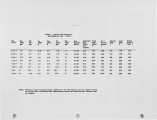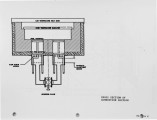| OCR Text |
Show water fill a flow rates were done by hand readings of the time to vessel to a given weight. On two occasions the emissions were measured by personnel from Southern California Gas Co. Testing Center using their van mounted portable recording system. When it was used, recordings were made of NOx, Oz, CO, C02' and hydrocarbons in the exhaust. During the testing considerable development was accomplished to achieve combustion, emissions, operating temperature and regenerative operation as required. Specifically, the burner zone concept was developed during the test program. The design is presently the subject of a new patent application, so cannot be disclosed yet. However, it retained the ideas of rapid and thorough mixing of fuel and air and intense radiation from the combustor surface. Final Test The burner was set at flow rates corresponding to a little less than would be desirable for a medium temperature industrial load. This operating condition was held for several hours and then brought to test conditions. During this period measurements were made of bagged samples These were made in three ways: 1) from each burner segment separately collected from a sample port in the chamber, and 2) from the exhaust pipe with each burner segment separately collected, and 3) from the chamber averaged over several complete cycles of both segments. Continuous sampling of emissions and combustion products were drawn from the chamber in a fourth method. This appeared to yield the most reliable data. Continuously drawn samples taken from the chamber were all that were analyzed. Table I shows the results and reduced data of the key operating points at which the RRB operated. It should be recognized that the 11:42 and . 12:30 tests are reasonably typical of at least another 1~ hours of running before 11:42 AM. Discussion of Results The data presented on Table I were gleaned from the charts and records taken during the July 2, 1992, run. Two records of emissions were made, one with the Southern California Gas Co. Emission Test Van by the SCG crew. The other was made using the Enerac. Temperatures and flow rates were taken as stated in the previous section. There was general agreement on emission measurements between the two sets of data (except that the Enerac 2000 reading of C02 was a derived figure, so was meaningless for this test .with diluent present). The SCG data were accepted as the most plausible set. |












